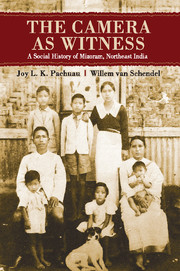Book contents
- Frontmatter
- Contents
- List of Figures
- List of Maps
- Acknowledgements
- I Becoming Mizo
- 1 Introduction
- 2 Coming into View: The First Portraits
- 3 Adjusting Mizo Culture
- 4 Domesticating a New Religion
- 5 Getting Educated
- 6 Controlling the Hills
- 7 The Trouble of Travel
- 8 First Stirrings of the Market Economy
- 9 Mizos in the World Wars
- 10 Mizo Visual Sensibilities
- II Mizoram in the New India
- III Visions of Independence
- IV Mizo Modernities
- Copyrights and Sources
- Glossary
- Bibliography
- Index
4 - Domesticating a New Religion
from I - Becoming Mizo
Published online by Cambridge University Press: 05 May 2015
- Frontmatter
- Contents
- List of Figures
- List of Maps
- Acknowledgements
- I Becoming Mizo
- 1 Introduction
- 2 Coming into View: The First Portraits
- 3 Adjusting Mizo Culture
- 4 Domesticating a New Religion
- 5 Getting Educated
- 6 Controlling the Hills
- 7 The Trouble of Travel
- 8 First Stirrings of the Market Economy
- 9 Mizos in the World Wars
- 10 Mizo Visual Sensibilities
- II Mizoram in the New India
- III Visions of Independence
- IV Mizo Modernities
- Copyrights and Sources
- Glossary
- Bibliography
- Index
Summary
The different sub-groups of the hill people shared many notions about earthly existence and life after death. We can speak of this cluster of shared notions – for which they did not need a single term – as the hill religion. We have only very limited visual material to explore and illuminate religious ideas and practices prior to colonial rule – and even less to explain the hill people's remarkable openness to new ideas and practices. Their ready acceptance of Christian ideas was the major cultural transformation of the colonial period (1891–1947), the focus of this chapter.
The earliest Europeans who contacted the hill people were baffled by their religion and often doubted that they actually had one. In 1798, Francis Buchanan questioned six individuals and concluded: ‘They have no writing, nor Priests: nor could I discover, that they had any belief in a God, nor in a state of future existence’. Meeting them again and probing further, he learned that,
they acknowledged two Gods, a female named Po-vang, and a male named Sang-ro. The headman did not pretend to know where these Gods reside: but he said, that on certain occasions their old men and Women directed the performance of Sacrifices. These rites were also vowed by those who were in apprehension of a bad crop, or of danger from sickness. The sacrifice is performed by killing fowls, Goats, Swine, and the like; the blood is offered to the Deity, and the flesh serves for a feast … I have not been able to discover, that they have any Idea of a future state.
They expressed their ‘ideas of a future state’ in rituals, stories, dance and songs but rarely visualized them in forms that are readily accessible today. Visual representations of their religious activity do not become available until the 1870s. Figures 4.1–4.3 show invading British troops posing in front of an elaborate shrine in northern Mizoram and closeups of the shrine and the ‘prayer house’ behind it.
- Type
- Chapter
- Information
- The Camera as WitnessA Social History of Mizoram, Northeast India, pp. 59 - 86Publisher: Cambridge University PressPrint publication year: 2015

